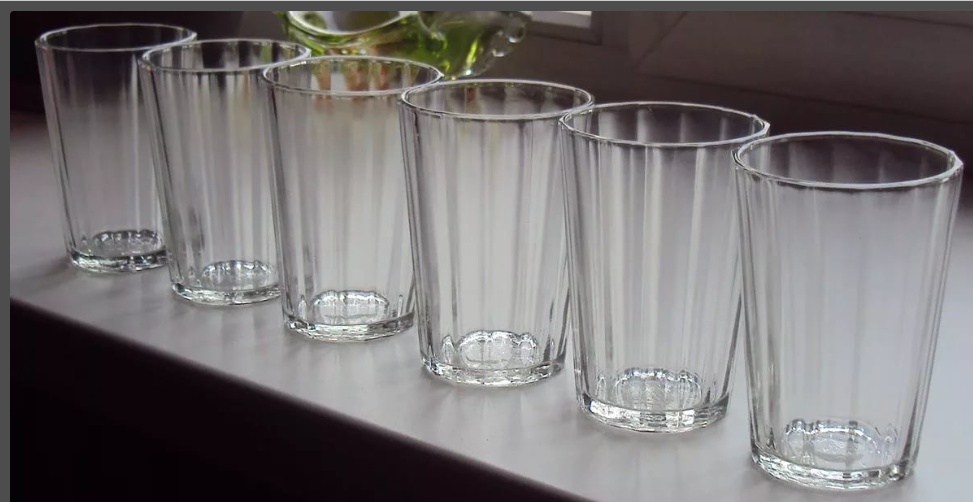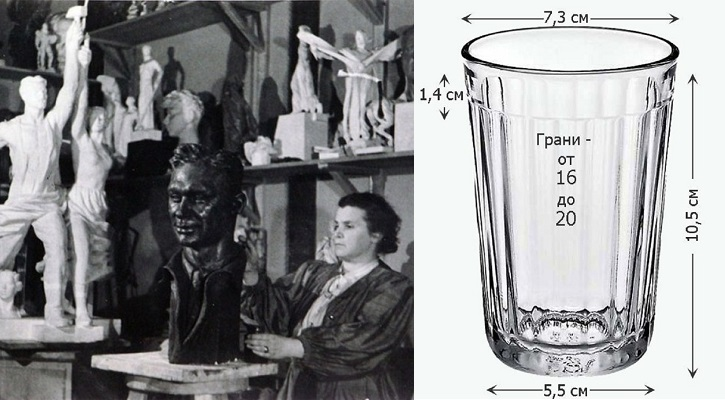Why did a faceted glass come to be called a lip glass?
We saw it on trains and public catering, in domestic films and in our parents’ kitchens. The ubiquitous faceted glass is one of the main symbols of the Soviet era.

And if you believe some historians, then even earlier periods of the country’s development. According to some sources, people first resorted to this type of utensils during the time when bells were melted down by Peter the Great.
The content of the article
Why is the glass faceted?
The explanation must be sought on the external part of the product. Its sides are repeatedly cut to form “ribs” or edges.
When did a glass with edges appear?
In fact the exact date of creation is unknown. There are several theories about this.

Version one
One of them says that the item was invented back during the time of Peter the Great. It was used by sailors who needed stable utensils.
The authorship of a convenient container, which, when tipped over on its side, was in no hurry to continue falling, is attributed to Efim Smolin from Vladimir.
Version two
According to another version, we must thank the American company Jervis for the “ribs” of the dishes and for their production using the pressing method.
Opponents of this theory insist that the company in question is significant only from a technological point of view. And the idea of a glass existed long before the birth of glassmaking in the United States.
Version three
Supporters of the third version claim that the authorship belongs to the merchants Maltsov. IN 1756 They built the first glass factory on the Gus River. This is where the concept of unusual dishes was born.
There are many versions! All that can be said with certainty is that a glass with ribs was widespread already in the first years of the 20th century.
Another version - “Mukhinskaya”
Well, specifically, September 11 is connected with Vera Mukhina and 1943. At that time she ran a glass workshop in Leningrad. She came up with a model of a glass that was distinguished by its stability.

She shared her sketches with management, and within a short time production began based on them. The very first glass was released at the Gus-Khrustalny plant on September 11, 1943.
Reference! Since then, September 11 has become a holiday - Cut Glass Day.
How many sides are there on a glass?
It turns out that the number of ribs on the walls of glassware varies. But their the number is always even!
In the thematic museum located in Urshele, Vladimir region, there is a service with 10 edges. And among the exhibits of the Gusev Experimental Glass Factory there is a set of dishes with 20. In addition to the presented options, products were produced with 8, 12, 14, 16 and 18 cut sides.
There was an attempt to produce glasses with an odd number of sides, namely from 17. But the idea was quickly abandoned due to the complexity of the technological process. An even number required much less effort and expense.
Important! The number of edges directly affected the cost. The more there are, the higher the price.
Why did the glass become lippy?
«Faceted"is not the only name of a popular product. V. Mukhina’s model differed from the glass available at that time in one detail.This is the rim that encircled the top edge of the product. The rim had no edges, and therefore fit better to the lips. And it was more convenient to drink from it.

This feature led to the emergence of a new name - “big-lipped».
But it was not the last.
Other names
The seemingly simplest object turns out to be rich in names! Here's another way to call it.

- «Malenkovsky" Comes from the name of the Soviet statesman Georgy Malenkov. During the Great Patriotic War, he was a member of the State Defense Committee.
Reference! Georgy Malenkov became famous among soldiers for introducing 200 grams of vodka into the daily ration of soldiers.
A faceted 250 ml Soviet-style glass for the defenders of the homeland in those years was not only utensils, but also a way to quickly and more or less accurately measure the required norm.
It was believed that if you pour “Malenkovsky” to the bottom edge of the upper rim, then 200 ml will come out, and if to the top edge - 250 ml.
- «Mukhinsky" There is no need to explain to whom the glass owes this name. This is how the people preserved the memory of the creator of the Soviet tableware model.
- «Maltsovsky" Another “notch” of historical memory. Remember about the glass factory on the Gus River? Merchant Akim Maltsov was the first director of this plant, which is why the glass received his name, which was used before the revolution.
All 3 options have taken root among the people. And in literature and official sources the word “faceted” is usually used.





